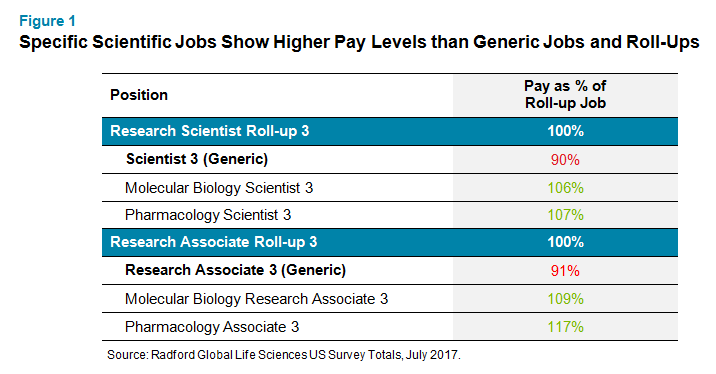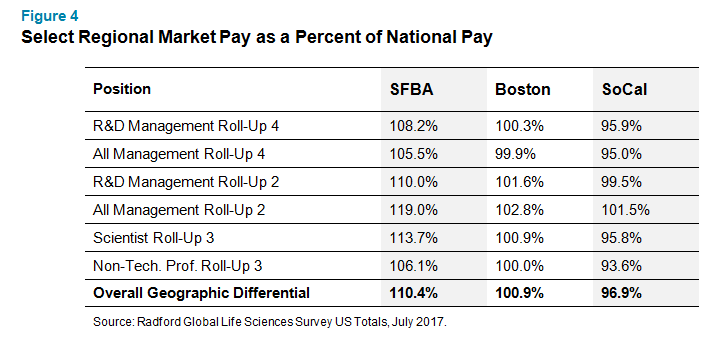From job matching to differentiating pay based on skills and geographic locations, we address some of the life sciences sector’s biggest compensation benchmarking challenges.

In the fall of 2017, we met with several hundred HR leaders at our annual life sciences sector meetings in Boston and the San Francisco Bay Area (SFBA). In each location, among a host of other issues, we spent a good deal of time discussing strategies for leveraging Radford data to develop effective rewards programs, including best practices for job matching and benchmarking.
Sound benchmarking techniques, job matching and job leveling are all essential to creating an effective rewards program. Think of these items as the foundation of your rewards house: it’s critical to get a solid foundation down before delivering rewards programs, creating career paths and launching recognition opportunities. However, creating this foundation can be a challenge for any organization, especially companies in high-growth mode. To assist with this process, we came up with the three most common job leveling and data questions we tend to receive as well as our answers on how best to solve them:
Question #1: Should we match our roles to Radford’s specific, generic or roll-up survey jobs?
The short answer, as always, is that it depends.
As a general rule, we encourage you to match your organization’s jobs as specifically as possible. Doing so generally ensures you’ll make the most accurate and appropriate compensation decisions. However, in some organizations, particularly in startup environments, employees may fill hybrid roles or wear multiple hats. In these instances, matching to one of Radford’s generic survey jobs may be the best approach. Additionally, for roles with low sample sizes, it may be sensible to rely on data from a “roll-up” job (i.e., a job created by combining data for two or more individual jobs from the Radford survey job list to provide a larger data sample than would be available for each job when reported separately). In such instances, matching to a roll-up job is necessary, as incumbent populations are more robust and reliable, though pay figures may look different. Keep in mind that it’s important to understand how the data might differ when using and applying roll-up job data; you may need to make some compensation adjustments from time to time.
For example, when we take a closer look at data from the Radford Global Life Sciences Survey, we see that the generic job role of Scientist and Research Associate carries a discount of roughly 10% compared to other more specific Scientist and Research Associate roles.
In our experience, small biotech companies tend to rely on generic matches while commercial companies with larger and more complex workforces use specific job matches. The differences in pay among Radford’s specific matches, generic matches and roll-up matches are illustrated in Figure 1.

Using the example of generic vs. specific scientific job roles demonstrates the importance of accurate job matching. We recommend matching jobs as specifically as possible when the data is available and resort to using roll-ups only in certain circumstances like the ones mentioned above. Taking the time to ensure your positions are matched to the right functions and levels provides more accurate compensation benchmarks and proper role differentiation.
Question #2: Do we need to pay extra for special credentials?
The answer to this question, too, is that it depends. When it comes to determining pay for employees with specific credentials, a more nuanced approach may be needed. In some cases, it makes sense to pay differently for special credentials, and in others it doesn’t. The hard part is determining what to look for on a case-by-case basis in order to make that decision and distinction.
As a general rule of thumb, medical degrees command a pay premium regardless of job scope or level and are most often found in management-level jobs as illustrated in Figure 2 below.

For PhD credentials, pay increases are mostly driven by a change in the scope of employee roles as illustrated in Figure 3 below. If a PhD is not needed to perform the day-to-day requirements of the job, the credential carries less of a premium. This is the case with Project/Program (R&D) Management roles, which do not require the credential to do the job.

Pay can vary significantly among jobs even within the same function and level. If you’re looking to hire employees with additional credentials, make sure your ranges are flexible enough to accommodate attractive offers.
Question #3: Should we differentiate pay between our geographic hubs?
Not all markets are created equal, and fortunately, our survey data allows you to do a deeper dive into the pay differences between geographies. For those companies with talent scattered throughout the country, it’s critical to stay in line with the market while also maintaining internal pay equity. To do this, make sure your ranges are wide enough to accommodate pay for employees in all regions or create parallel ranges that reflect local markets.
When we look at median base salary differentials in key life sciences hubs (see Figure 4), we see a significant premium in cash compensation for the SFBA while Boston-based companies are more aligned with the national average. (However, we note that national Radford data are higher than average US data due to a high concentration of incumbents in coastal/major metropolitan areas). Given the uniquely hot job market in the SFBA, it is critical that compensation reflect this distinction.

Next Steps
When fully understood and interpreted, Radford data can be harnessed to paint a detailed picture of the market and to drive effective, differentiated rewards programs. But this process must start with getting the basics right. Answering foundational questions around job matching and benchmarking can help set your pay strategy on the right course.
*****
To learn more about participating in a Radford survey, please contact our team. To speak with a member of our compensation consulting group, please write to consulting@radford.com. For information about upcoming Radford events, click here.
Related Articles